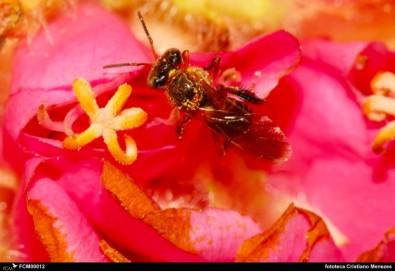Frieseomelitta varia is a docile species of economic interest as a pollinator; Its workers are sterile, and some of its genetic sequences are identical to those found in other eusocial bees, pointing to the conservation of ancestral traits

Credit: Cristiano Menezes
A consortium of researchers funded by Brazil’s National Council for Scientific and Technological Development (CNPq) and FAPESP has sequenced the genome of Frieseomelitta varia, a native stingless bee (common name: marmelada). The feat extends scientists’ understanding of the evolution of stingless bees (Meliponini) and paves the way for the breeding of commercially useful species.
The researchers are affiliated with six Brazilian universities. The findings are published in BMC Genomics in a paper coauthored by researchers at the University of São Paulo (USP), São Paulo State University (UNESP), the Federal University of São Carlos (UFSCar), the Federal University of Alfenas (UFAL), the Federal University of Jequitinhonha and Mucuri Valleys (UFVJM), and the Federal Technological University of Paraná (UTFPR).
“We chose a species to test our ability to sequence a whole genome in a pilot project. F. varia is an emblematic species because its workers are completely sterile. This is a trait that distinguishes it from the vast majority of species in the tribe Meliponini,” said Klaus Hartmann Hartfelder, a professor in the University of São Paulo’s Ribeirão Preto Medical School (FMRP-USP) and corresponding author of the paper.
The study was part of a project supported by FAPESP. The principal investigator for the project was Zilá Luz Paulino Simões, a professor in the University of São Paulo’s Ribeirão Preto School of Philosophy, Science and Letters (FFCLRP-USP) and a coauthor of the paper. The sequencing was performed at the Central Laboratory for High-Performance Technologies in Life Sciences (LaCTAD) at the University of Campinas (UNICAMP), also with FAPESP’s support.
The sequencing revealed a large number of repeated noncoding long RNAs, which have a regulatory function. In humans, for example, these RNAs are associated with processes that regulate development of the central nervous system, among others. In F. varia, the researchers believe that these sequences may be linked to the lack of ovaries that makes the workers sterile. The queen is highly fertile, of course.
“As in the vast majority of social insects, the eggs are all the same. Any egg can develop into a worker or queen. During the larval stage, however, some molecular signaling pathways diverge so that the bees differentiate into two types of individuals, one fertile queen and many infertile workers,” Hartfelder said. “In the Western honeybee Apis mellifera, this is engineered by giving the queen different food in the larval stage, but in stingless bees, it seems to be more a matter of the amount of food.”
Evolutionary advantage
The group also found a high degree of conservation (synteny) in a block of genes described in A. mellifera related to pollen hoarding by colonies. This is typical of highly social species, whereas others collect only enough pollen to feed their larvae.
“The finding surprised us, given that A. mellifera and stingless bees diverged into different lineages more than 70 million years ago. That’s a long time for a species to conserve a trait as it evolves,” Hartfelder said. “We want to see if the same is true of other bees and if it happened by chance or afforded an evolutionary advantage.”
Another interesting finding was the difference between the stingless bee species studied and other bees in terms of the arrangement of genes in the mitochondrial genome, which was also sequenced as part of the study. The alteration of the cellular energy factory’s gene order may have evolutionary implications worthy of being studied in greater depth in the future.
Pollination of food crops
The nests built by colonies of F. varia are coated on the outside with plant resin that acts as a repellent to keep away ants and other potential invaders. The species produces little honey but is docile and sufficiently widely distributed, especially in the southeast of Brazil, to be used as a pollinator of high-added-value food crops grown in hothouses. The Western honey bee has not adapted well to indoor environments.
The discoveries regarding the genome of F. varia will also help guide the search for desirable traits in other species of commercial interest, such as Tetragonisca angustula (common name: jataí).
In the study, the group used the experience acquired by international consortia in sequencing bee genomes. In 2006, the researchers took part in the sequencing of A. mellifera‘s genome. The result was published in Nature.
In 2015, they participated in a study, reported in Science, that sequenced ten bee genomes, including that of Melipona quadrifasciata, the first Brazilian stingless bee genome ever sequenced. In the same year, they participated in the sequencing of the genomes of two bumblebees (Bombini), which belong to the same lineage as honeybees (Apini) and stingless bees.
The next step in the research will entail a more detailed study of some regions of F. varia‘s genome that drew attention. In addition, thanks to the knowledge gleaned from previous studies, the group have already selected five other species whose genomes will be sequenced.
###
About São Paulo Research Foundation (FAPESP)
The São Paulo Research Foundation (FAPESP) is a public institution with the mission of supporting scientific research in all fields of knowledge by awarding scholarships, fellowships and grants to investigators linked with higher education and research institutions in the State of São Paulo, Brazil. FAPESP is aware that the very best research can only be done by working with the best researchers internationally. Therefore, it has established partnerships with funding agencies, higher education, private companies, and research organizations in other countries known for the quality of their research and has been encouraging scientists funded by its grants to further develop their international collaboration. You can learn more about FAPESP at http://www.
Media Contact
Heloisa Reinert
[email protected]
Original Source
https:/
Related Journal Article
http://dx.




